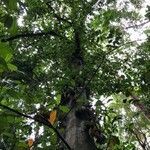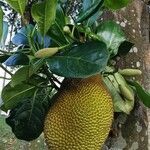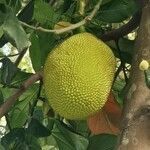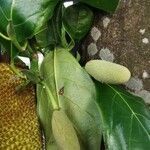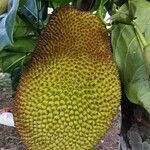Tree up to c. 30 m tall, evergreen. Leafy twigs 2-4 mm thick, whitish puberulous (or punctate) and also brown hirtellous to (sub)hirsute, sometimes only (and sparsely) on and near the nodes, the hairs with swollen bases and sometimes uncinate, sometimes glabrous, drying dark brown to blackish; lenticels scattered, few. Leaves spirally arranged; lamina subcoriaceous, entire (or when juvenile to 3-lobate), elliptic to (sub)obovate, (4-)8-20(-27) by (1.5-)4-8(-12) cm, apex acuminate, base cuneate to obtuse to rounded, often slightly unequally, margin entire, ± revolute; upper surface whitish puberulous and brownish strigillose on the whole surface or only on the main veins or midrib, or glabrous; lower surface whitish puberulous and brown hirtellous on the whole surface or only on the main veins, the hairs all or partly uncinate, or (becoming) glabrous, smooth; lateral veins 6-12 pairs, tertiary venation towards the margin (obliquely) scalariform or largely reticulate, slightly prominent to almost flat; petiole 0.8-3 cm long, 1-2 mm thick, brown (sub)hirsute or also whitish puberulous, the epidermis persistent; stipules fully amplexicaul, 1.5-5(-9) cm long, (sparsely) brown (sub)hirsute to hirtellous to strigillose, the hairs with ± swollen bases and some uncinate, or also whitish puberulous, caducous. Staminate inflorescences axillary or cauliflorous on slender leafy branchlets, solitary; peduncle 2.5-6 cm long, brown hirtellous, also white puberulous; head narrowly ellipsoid to cylindrical to spicate, 1.5-5.5 by 0.9-1.2 cm; perianth tubular 0.7-1 mm long, the apex 2-lobed, minutely puberulous; stamen 1-1.3 mm long, anther 0.2-0.3 mm long; interfloral bracts absent. Pistillate inflorescences axillary, ramiflorous or cauliflorous on slender leafy branchlets, solitary; peduncle 1.5-6.5(-10) cm long, brown hirtellous to (retrorsely) strigillose and most hairs uncinate or also whitish puberulous; head cylindrical to subobovoid; perianth tubular, brown puberulous to subhispidulous, the apex truncate to convex; stigma simple; interfloral bracts absent. Infructescences narrowly ellipsoid to ellipsoid to ovoid (to subglobose), 15-35 by 10-15 cm, covered with 1.5-3 mm long, cylindrical to conical to pyramidate apices of the perianths; fruits ellipsoid, c. 3 cm long.
More
A tree up to 20-35 m tall. The trunk can be 55 cm across. The bark is dark grey or red-brown. The twigs are 2-4 mm thick. The leaves are leathery. They are oval and 5-25 cm long by 2.5-12 cm wide. The base of the leaf tapers. The flowers occur singly in the axils of leaves. The male heads are pale green or yellow. They are finger like and 30-55 mm long by 9-12 mm wide. They are smooth. The flower stalk is 25-60 mm long. The fruit is a compound fruit. It is produced on the trunk and main branches. It can be 20-50 cm long by 10-15 cm wide. The skin is yellow to brown. There are many fleshy spines over the fruit. The flesh of the fruit is yellow to light brown, It has a slimy texture. The fruit are edible. The seeds are oblong. They are 30 mm long by 20 mm wide. They are covered in a cream slimy coat.
